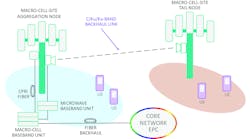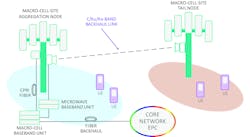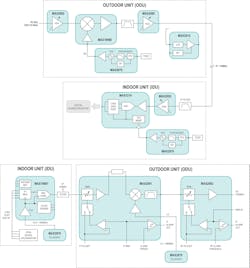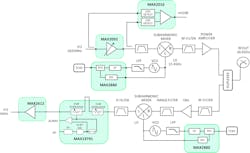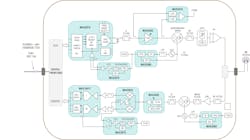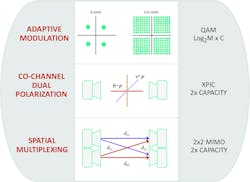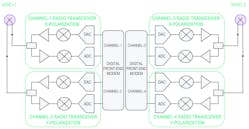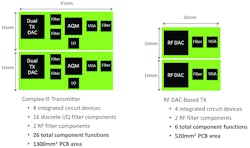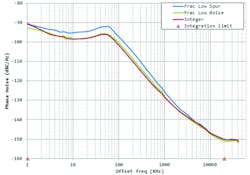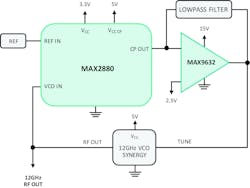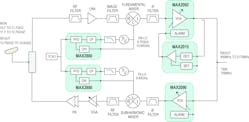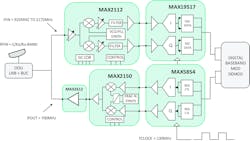Download this article in .PDF format
Introduction
This article is Part 2 in a two-part series about the mobile wireless backhaul systems deployed in 4G heterogeneous networks (HetNet). The series presents different equipment categories and emerging trends in equipment segments. Microwave, millimeter wave, and sub-6-GHz radio applications in small-cell and macro-cell base stations are discussed. The role of radio frequency (RF) analog integration and high-performance RF building blocks is explored with a focus on point-to-point microwave systems and broadband satellite systems.
Part 1 of this series examines the equipment trends and the different solutions deployed in cellular radio-access networks. It discusses equipment segmentation and equipment configurations, and considers the selection criteria for engineering a backhaul solution.
This article, Part 2 of the series, focuses on the point-to-point microwave and broadband satellite systems typically used for backhauling in macro-cell and small-cell base stations. It discusses techniques to improve radio-link spectral efficiency and radio lineup scenarios. The role of RF analog integration is explored and relevant RF solutions presented.
Conventional Point-to-Point, Line-of-Sight Microwave Systems
Conventional point-to-point (PTP), line-of-sight (LOS) microwave systems operate in the licensed spectrum from C-band up to Ka-band. Common operating band frequencies are 6, 11, 18, 23, 26, and 38 GHz. These systems require unobstructed LOS. Figure 1 illustrates a PTP microwave backhaul link connecting a macro-cell base-station tail node to an aggregation node. For small-cell base-station applications some microwave equipment vendors have demonstrated non-line-of sight (NLOS) operation using conventional LOS microwave bands. This NLOS operation is achieved by leveraging high antenna gain characteristics with operating guidelines for the well-known electromagnetic wave propagation effects of diffraction, reflection, and penetration.
Microwave Backhaul Configurations
The two most common microwave backhaul equipment configurations for macro-cell base-station applications are the split mount unit (SMU) and full outdoor unit (FODU). An SMU configuration comprises two separate boxes: an indoor unit (IDU) and outdoor unit (ODU). The FODU is a single unit that integrates the IDU and ODU functions. The FODU and split-mount ODU are installed at the tower top where they are exposed to harsh environmental conditions and extreme temperature changes. Because of the environmental exposure, all of these outdoor units need to be housed in a hardened enclosure.
Split Mount Unit (SMU) Radio
In an SMU system the IDU transmits and receives two different low-intermediate frequencies (IF1), one for the transmitter (TX) channel and one for the receiver (RX) channel. IF1 is routed over coaxial cable between the IDU and ODU. The IDU also handles TDM or Ethernet data routing and transport.
At the IDU a common receiver IF1 ranges from 120 MHz to 140 MHz and a common transmitter IF1 ranges from 310 MHz to 350 MHz (Fig. 2). The 350 MHz and 140 MHz IF, along with DC power, are routed over coaxial cable between the IDU and ODU. At the tower top within the ODU, a second IF (IF2) is synthesized at L-band or S-band which ranges from 1 GHz to 4 GHz. IF2 is then upconverted to, or downconverted from, the desired microwave carrier frequency (RF OUT/IN)—for example, 26-GHz carrier (Fig. 3).
Full Outdoor Unit (FODU) Radio
In a FODU configuration the entire radio is located within the outdoor unit. A high-speed serial interface, such as 1000BASE-T with Power-over-Ethernet (PoE), connects the FODU and baseband unit (reference Fig. 7, Part 1) or microwave router. In some small-cell applications the FODU may interface directly with a small-cell base station via PoE, where the small cell acts as the power source equipment (PSE) and the FODU is the powered device (PD). Figure 4 shows a typical RF to Bits radio transceiver front-end.
The FODU configuration in Fig. 4 is basically a bits-to-RF and RF to Bits box that moves digital transport, typically Ethernet, and handles all modulation/demodulation, analog-to-digital/digital-to-analog signal conversion, and up-/down-frequency conversion. The frequency lineup for the FODU is different than the SMU because the FODU has two up-/down-frequency conversion stages (IF1 and RF OUT/IN) and the SMU requires three up-/down-frequency conversion stages (IF1, IF2, and RF OUT/IN).
Generally in a FODU radio lineup, IF1 can range from 1 GHz to 4 GHz. IF1 assignment is driven by complexity and the cost of the image-reject filter, based on carrier frequency, channel bandwidth, image separation, and LO rejection. In a C-band application, for example, the carrier ranges from 6 GHz to 8 GHz and channel bandwidth can extend to 56 MHz. Therefore, IF1 can be as low as 1 GHz, allowing a low-Q image filter to achieve the necessary LO and image rejection. In a Ka-band application operating at 32 GHz or 38 GHz, the IF1 might be set at 4 GHz, which yields wider image separation to help relax the image-reject filter requirement.
Increase Capacity with Better Spectral Efficiency
Optimize spectrum utilization and achieve the lowest cost-per-bit transmission—these are top priorities for service operators. Per telecommunication regulations, a service operator’s PTP microwave link is confined to an assigned channel size or channel bandwidth at an agreed licensing fee. To increase capacity an operator can license more RF spectrum, but this incurs more cost. And in many cases, more RF spectrum may not be available. Ultimately, to achieve capacity gains within the constraint of assigned channel size, but without incurring more spectrum licensing cost, some advanced communication techniques are required.
Three common techniques are used to improve spectral efficiency and increase system throughput without using more radio spectrum: 1) adaptive modulation, 2) co-channel dual polarization (CCDP), and 3) spatial multiplexing (SM) (Fig. 5).
Adaptive modulation dynamically changes modulation constellation to achieve maximum throughput under varying weather conditions and different link budgets. There are two benefits of adaptive modulation: maintaining service quality by ensuring radio link operation under poor conditions, and achieving the highest throughput in a bandwidth-limited channel. As presented in Claude E. Shannon’s classic theorem, the capacity of a communication channel is defined by signal-to-noise ratio (SNR) and transmitter power.
Adaptive modulation uses Shannon’s theorem as a blueprint to optimize spectrum utilization. In clear weather conditions when radio-link SNR is high, the spectral efficiency and throughput are increased by employing dense QAM constellations such as 256 QAM, 1,024 QAM, or even 4,096 QAM. In poor weather conditions as SNR degrades, the modulation can be lowered to 16 QAM or QPSK to ensure link operation for high-priority data but at reduced throughput.
However, shifting to more dense QAM constellations yields a point of diminishing returns in terms of throughput gained versus added cost, RF transmitter power expended, required RF signal-chain linearity, and higher dynamic range. With each increase in QAM density (e.g., 64 QAM, 1,28 QAM, 256 QAM), a 3-dB to 4-dB increase in SNR or transmitter power is needed. But with each increase in QAM density the throughput only improves by about 10%. So in summary, the RF signal-chain performance must be doubled to achieve a 10% incremental gain in throughput. Consequently, other means are needed to significantly improve spectral efficiency and yield higher capacity gains.
Co-channel dual polarization (CCDP) utilizes cross-polarization interference cancellation (XPIC) to double link capacity over the same channel. CCDP-XPIC allows simultaneous transmission of two separate data streams on the same frequency. Data is transmitted on orthogonal antenna polarizations (vertical and horizontal) and cross-polarization interference is cancelled using digital signal processing.
Spatial multiplexing (SM) significantly improves spectral efficiency. SM uses multiple-input multiple-output (MIMO) antennas to send multiple data streams over the same RF channel. A 2 × 2 MIMO link can double capacity. SM with MIMO, used in many wireless applications including LTE access and 802.11n/ac WLAN, relies on multipath interference and exploits spatial propagation paths caused by reflections. There is a minor complication, however. The nature of a LOS microwave link does not exhibit multipath, so a multipath condition is simulated by intentional antenna separation, thereby creating a pseudo multipath condition.
Combining adaptive modulation with CCDP and MIMO techniques will yield considerable capacity gains, but there are always trade-offs to be made. A 2 × 2 MIMO radio requires two transceiver paths (two transmitters and two receivers) with each transceiver dedicated to a single antenna. A CCDP radio requires two transceiver paths, one transceiver dedicated to each antenna polarization. However, adopting 2 × 2 MIMO with CCDP requires four RF transceiver paths (Fig. 6). This 4× increase in RF channel density delivers a major benefit: a 4× increase in link throughput without using more RF spectrum. When amortized over the equipment life span, the extra cost of additional radio hardware is offset by a significant savings in annual spectrum licensing fees.
Hot Standby—a Bonus with MIMO Adoption
There is another advantage of adopting 2 × 2 MIMO: it meets the requirement to support hot standby (HSB) redundancy. PTP microwave systems support HSB with basic protection of 1+1 HSB. This means that two radios are used: a primary radio and backup radio. If the primary radio fails, then the secondary backup radio is switched in. HSB is inherent with 2 × 2 MIMO radio architectures.
The purpose of HSB is to deliver five nines (99.999%) availability over an extended mean-time-between-failure (MTBF) period. In some cases the expected MTBF period can be up to five5 years. This level of sustained 24/7 protection is needed because of the critical nature of the radio link and the installation location. Think about it: Wireless backhaul equipment can be part of a mission-critical public-safety radio link, or located in a macro-cell base-station site supporting many mobile subscribers, or at a tower-top location where maintenance must be scheduled, or at a remote hard-to-reach base-station site.
Consider that four radio transceiver channels are required with 2 × 2 MIMO CCDP 1+1 HSB. Further, as modulation constellations increase from 256 QAM to 4096 QAM, better radio dynamic performance is necessary to achieve desired bit-error-rate (BER) and error vector magnitude (EVM) margin. The net effect of the wireless backhaul evolution is increasing RF signal-path channel density and the expectation of higher dynamic performance. All this translates into new demands for more analog integration by RF engineers.
Increasing Need for RF Analog Integration
Without sacrificing performance or reliability, smaller RF solutions are needed. This is where analog integration emerges as especially important. Recall the first IF transmitter section above. In an FODU transmitter the first IF can range between 1 GHz to 4 GHz, and in an SMU transmitter the first IF ranges from 310 MHz to 350 MHz. Also consider that adaptive modulation supports constellations from QPSK up to 4,096 QAM and, depending on the application, channel bandwidth can vary from 3.5 MHz to 112 MHz. Together, these factors dictate a software-defined radio topology that supports requisite EVM dynamic performance based on a common transmitter architecture platform.
A Versatile RF-DAC Transmitter for a Microwave PTP Platform
Designers have several radio architecture options when designing a first IF transmitter stage. Options include: zero-IF, complex-IF, real-IF, and direct-RF.1
However, suppose that the microwave PTP transmitter platforms must support high-order modulation, wide bandwidths, software-defined radio capability, low power consumption, and compact size. Now the best architecture is direct-RF conversion using an RF digital-to-analog converter (RF DAC) with direct digital synthesis (DDS). Figure 7 illustrates a direct-RF transmitter using the MAX5879 RF DAC to synthesize an IF of 2 GHz.
- The benefits of the RF-DAC transmitter are significant: It can be used in split-mount indoor units to directly synthesize the 350-MHz IF. It can be used in the FODU to directly synthesize up to 2.8-GHz IF, where it serves as a common transmitter platform spanning different equipment configurations.
- They require fewer discrete devices and occupy considerably less printed-circuit-board (PCB) area (Fig. 7). This significant reduction in size is critical for space-constrained MIMO and CCDP radios.
- The DDS-based RF-DAC transmitter architecture eliminates gain-phase errors and achieves perfect carrier suppression with no LO leakage. This is vital for meeting the strict EVM requirements necessary to transmit high-order modulation signals with dense constellations like QAM-2048 at low BER.
- It consumes about 1W less power per channel than conventional architectures. In a FODU radio using 2 × 2 MIMO with CCDP and powered by POE+, this translates to a 4W power savings or 15% of the POE+ power budget. Also lower power means less heat dissipation, a critical concern for passively cooled outdoor units subjected to high-temperature extremes approaching 40°C.
Essential RF Building Blocks
While it is clear that dense RF analog integration is vital to shrink size and lower component count, there are still many radio functions that rely on RF building blocks. Two RX-TX areas require several key analog functions: the IF section and microwave up-/down-frequency conversion sections, as shown in Figs. 2, 3, and 4. Two requisite circuit functions are the phase-locked loop (PLL) frequency synthesizer and the variable gain amplifier (VGA).
PLL Frequency Synthesizer
In the IF section of the RX and TX signal paths a PLL frequency synthesizer generates the mixer LO and high-speed ADC/DAC conversion clocks ranging from 100 MHz to 4 GHz. The device commonly used must integrate a VCO and fractional/integer-n PLL, and offer wide frequency coverage. The MAX2870/MAX2871 are a common choice.
In the RF microwave section a PLL frequency synthesizer is used to generate the high-frequency LO for either a fundamental mixer or subharmonic pumped mixer. The LO frequency can range from 6GHz to 12GHz, depending on the final carrier frequency. A PLL with external VCO like the MAX2880 is typically used.
Both PLL synthesizer applications require excellent phase noise and spurious performance which directly impacts system capacity. As stated above, a PTP microwave radio can use modulation constellations up to 2,048 QAM or 4,096 QAM to achieve high spectral efficiency and deliver high throughput. Supporting dense modulation constellations requires a PLL synthesizer phase-noise margin and spurious performance that will not significantly degrade EVM. This preserves the radio link SNR and allows the system to achieve maximum capacity and throughput. Figure 8 shows the MAX2880 phase-noise performance at fOUT = 12 GHz. Over a 20-MHz integration bandwidth and setup for integer-n mode, the MAX2880 achieves EVM of -43.6dB. For a 2048QAM radio lineup, this translates to only 0.6dB degradation in EVM with +10dB SNR margin.
An important PLL frequency synthesizer feature is independent dual-channel RF outputs that can be set to different power levels and output frequencies. This capability is helpful for generating both the LO and high-speed converter (ADC or DAC) conversion clock from a single device. In an example zero-IF RX architecture with IF = 1.9GHz and 56-MHz channel bandwidth, the analog quadrature demodulator LO can be set to 1.9 GHz with LO drive level at +2dBm; the high-speed ADC clock is set to 118.7 MHz (divide-by-16) at +5dBm. Using a single device like the MAX2871 with independent dual-RF output ports and independent output power levels means that an extra synthesizer, LO buffer, and clock buffer can be eliminated. The system level advantages are lower cost and smaller occupied PCB area.
VGA Serves ATPC Functions
Automatic transmit power control (ATPC) is a critical function in PTP microwave radios. ATPC is used to increase the transmitter power level during a fade event and, thus, maintain link quality under adverse environmental conditions. ATPC also lowers interference with adjacent channels. Further, ATPC can be used in conjunction with adaptive modulation to change the transmitter power level based on desired modulation. In this way power back-off is optimized and dynamically set for individual modulation constellations. ATPC improves link availability by maintaining adequate SNR and conserves energy by reducing average operating power consumption.
Guidelines for ATPC are up to 20dB dynamic range in 1dB steps with 100 dB/s tracking speed. Typically, transmitter output power tolerance is ±1dB. When used with adaptive modulation, the gain range must cover an additional 8dB to 10dB to compensate for PA back-off under different modulation scenarios from QPSK to 4096QAM.
The VGA is an important component for ATPC operation and throughout the signal-chain lineup. It ensures a proper signal level in the RX and TX paths. In the TX path of an SMU a VGA is also important for compensating cable loss and equalization. Key features of a VGA for ATPC applications are high linearity overtemperature, wideband performance, and linear-in-dB control with integrated alarm circuits.
Figure 9 shows how a wideband VGA uses a proprietary technique to achieve highly linear control-voltage response over the temperature range of -40°C to +95°C. High linearity over temperature is critical for FODU radios that are subject to wide operating temperature extremes. Note that the device operates at an IF from 700 MHz to 2.7 GHz. This range enables partial power control at IF and support for full ATPC at RF (i.e., from 6 GHz up to 40 GHz). Augmenting power control at IF requires another 10 dB to 15 dB of VGA dynamic range to compensate for impairments in the subsequent RF stages. Impairments include insertion loss, gain variation, and component temperature drift. Also in SMU applications, the VGA might need to provide 6-dB cable loss compensation. This is why the example VGA, the MAX2092, has up to 40 dB of dynamic range and +18 dBm P1dB (i.e., ATPC range = 6 dB; modulation back-off = 8dB; impairment compensation = 10dB’ cable loss compensation = 6dB; total VGA range = 30 dB).
Satellite Backhaul
Commercial satellite systems use very small aperture terminals (VSAT) for cost-effective delivery of telephony, broadband access, and video content. VSAT systems are deployed in enterprise-grade private networks, consumer broadband services, and cellular base-station backhaul. In cellular base-station backhaul applications, VSAT systems are ideal for remotely located small-cell sites. Figure 10 shows a typical VSAT system used in a base-station backhaul application.
Router and gateway VSAT terminals are ground-based units with a two-way communication link to C/Ka/Ku-band satellites. The satellites can be geosynchronous earth orbit (GEO) or medium earth orbit (MEO). The size of a ground-based VSAT antenna ranges from 75cm up to 3m.
Orbiting satellites are powered by a finite energy source and, therefore, are energy constrained. Because of this, a satellite downlink channel has limited transmitter power. The link is also susceptible to atmospheric loss because geosynchronous satellites orbit at 35,000 km from ground terminals. As a result, the radio link operates with low SNR. To achieve desired data throughput with acceptable BER at low SNR, VSAT systems use wide-channel bandwidths with relatively low-order modulation such as QPSK, 8 PSK or 16 APSK.
Conventional satellites occupy 500 MHz to 1 GHz of spectrum comprising multiple transponders with bandwidth from 27MHz, 36MHz or 54MHz. A new generation of high-throughput satellites (HTS) operates at Ka-band where more RF spectrum is available. The Ka-band satellites can have up to 120 individual spot beams reaching a capacity of 150 Gbps. The HTS Ka-band systems use wide transponder channels with up to 500 MHz bandwidth.
There are two main radio elements in a VSAT system: an ODU and an IDU. The topology is similar to a microwave point-to-point SMU. The ODU, located at the antenna dish, handles block frequency translation of the C/Ka/Ku-band microwave carrier (6/4 GHz, 14/12 GHz, 30/20 GHz) to an L-band intermediate frequency (IF = 925 MHz to 2,175 MHz). The IDU handles up/down frequency conversion from L-band IF to baseband.
VSAT Radio Solutions
Figure 11 illustrates a typical ODU microwave up-/down-frequency converter operating at Ku-band. The ODU comprises two blocks: the low-noise block (LNB) receiver, and the block upconverter (BUC) transmitter. Circuit operation is similar to a microwave PTP backhaul radio where fundamental and sub-harmonic pumped mixers are used with PLL frequency synthesizers. In applications where the LNB and BUC operate at fixed frequencies and where frequency drift is not an issue, the PLL can be replaced with a dielectric resonator oscillator (DRO). The DRO exhibits typical frequency drift ranging from ±1 ppm/°C up to ±4 ppm/°C.
For a 10-GHz design operating over -10°C to +45°C temperature range this equates to frequency drift of 550 kHz to 2.2 MHz. This frequency variation over temperature could be a problem in outdoor units that are subjected to wide operating temperature extremes or single Channel per Carrier systems. Nonetheless, in many VSAT applications, the DRO is a low-cost alternative to a PLL frequency synthesizer.
IDU VSAT terminals require wideband frequency coverage and high dynamic range with selective tuning to a desired transponder channel. An important feature set for broadband VSAT tuners includes a high-dynamic-range VGA; a fractional-n synthesizer using multiple VCOs for LO tuning; and baseband I/Q filters with variable bandwidth control. A direct-conversion broadband VSAT tuner is shown in Fig. 12.
The broadband tuner has wideband frequency coverage from 925 MHz to 2,175 MHz to support the L-band ODU output spectrum. The LO is generated by an integrated 20-bit fractional-n frequency synthesizer with tuning resolution down to 26 Hz. The internal lowpass filters are programmable from 4 MHz to 40 MHz, covering all common transponder channel bandwidths. The VGA stages deliver over 80 dB of gain range to account for downlink path loss effects such as rain fade, foliage obstruction, polarization loss and antenna de-pointing loss.
ODU and IDU radios designed for commercial VSAT systems leverage highly integrated, application-specific analog semiconductors complimented by high-performance RF building blocks. Together this combination delivers the size, cost, and performance requirements needed in broadband satellite-backhaul applications. To deliver higher data throughput, the next-generation VSAT systems will take advantage of HTS satellites operating at Ka-band where a greater amount of spectrum is available. This advance will, in turn, drive demand for new RF-analog solutions that can meet the bandwidth, dynamic performance, size, and cost requirements of emerging small-cell backhaul deployments.
Conclusion
4G cellular networks are evolving to a HetNet topology with access layer coordination among macro-cell base stations, different classes of small-cell base stations, and distributed antenna systems. HetNet will improve network capacity and coverage for broadband mobile users who desire higher data throughput and demand excellent quality of experience. Meanwhile, backhaul transport is emerging as a critical HetNet element that brings together mobile users, radio access networks, and the core network. Wireless backhaul is an important tool in the backhaul “toolbox” and will be relied upon more heavily for 5G access in coming years.
Microwave and broadband satellite backhaul are two common wireless technologies deployed across the radio access network. As base-station capacity and throughput increase to support growing mobile data demand, backhaul capacity must likewise increase. And as base-station size and power decrease, so must backhaul solutions. As such, wireless backhaul systems will continue relying on RF analog integration and RF building-block solutions to achieve high spectral efficiency, smaller form factor, and lower operating power.
Reference
1. For an in-depth discussion, see Maxim Integrated application note AN5317, “Implementing a Direct RF Transmitter for Wireless Communications.”
